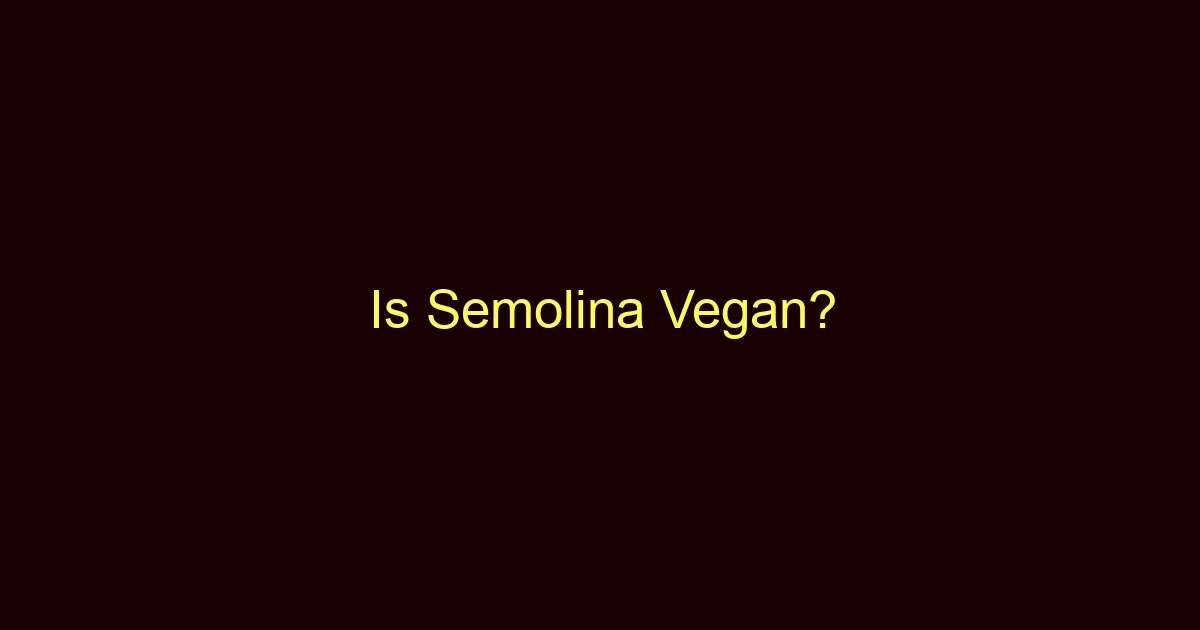Semolina, a popular ingredient in many culinary traditions worldwide, has often been the subject of debate within vegan and health-conscious circles. For those who are new to semolina or wish to understand its place in a vegan lifestyle, this article will guide you through the fascinating world of this versatile foodstuff.
What is Semolina?
Semolina, a coarse grind of high-protein wheat, is most often associated with Italian cuisine, especially pasta and bread making. The unique texture of semolina, its pleasant, slightly nutty flavor, and its high protein content make it a favorite in kitchens globally. It’s an unarguably versatile ingredient, finding a place in both sweet and savory recipes.
The type of wheat used to produce semolina is durum wheat, widely acknowledged as one of the hardest wheat types available. Thanks to this, semolina is endowed with a robust structure, capable of withstanding rigorous cooking processes. It’s this strength that provides pasta made from semolina with a delightful, al dente firmness that people worldwide have come to love.
What is Semolina made of?
Being derived from durum wheat, semolina is essentially made from the endosperm of the grain. This inner part is grounded to a coarse texture that can range from slightly sandy to grittier, depending on the milling process. The name “semolina” is actually derived from the Italian word ‘semola,’ meaning ‘bran,’ referencing the somewhat granular texture of the product.
As semolina comes from wheat, it naturally contains gluten, which is a critical component in its culinary use. Gluten gives semolina its distinctive structure and elasticity, making it ideal for baking and pasta making. However, this also means that semolina is not suitable for those following a gluten-free diet.
What is Semolina used for?
Due to its versatility, semolina has a wide range of uses in the kitchen. It’s popularly used in pasta production, but its uses extend far beyond that. You’ll find it as a key ingredient in many bread recipes, lending a unique chewiness and golden hue to the final product. Additionally, semolina is also commonly used in pastries, porridge, and even as a coating for certain pan-fried foods to give them a crispy exterior.
What Foods Contain Semolina?
Semolina is prevalent in a number of food products. It’s found in various types of pasta like spaghetti, macaroni, and lasagna sheets. In the baking world, semolina is often used to make bread, cookies, and even some cakes. In certain cultures, semolina is also used to prepare porridge, puddings, and sweet dishes like the Middle Eastern ‘basbousa’ or the South Asian ‘sooji halwa’.
Is Semolina Vegan?
Yes, semolina is vegan. It’s a product derived from wheat and does not contain any animal products or byproducts. Its production involves the milling of durum wheat, with no involvement of animal-derived elements at any stage.
While this makes semolina a suitable ingredient for vegans, it’s always important to check the labels when purchasing processed foods that contain semolina. Certain pasta or baked goods may also contain non-vegan ingredients like eggs or dairy products. However, pure semolina in itself is completely vegan-friendly.
Can vegans eat Semolina and why?
Absolutely! Vegans can definitely incorporate semolina into their diet. The reason is straightforward; semolina is plant-based, made from durum wheat, and does not contain any animal-based products. Plus, it’s a fantastic source of protein and fiber, two nutrients that are crucial for a well-rounded vegan diet.
However, it’s worth repeating that while pure semolina is vegan, always check labels of semolina-based processed food. Ensure they do not contain added non-vegan ingredients, such as milk, cheese, or eggs.
Exploring Semolina in Vegan Cooking
Vegan cooking can gain significantly from semolina due to its flexibility in both savory and sweet dishes. In savory recipes, semolina can be used to make vegan pasta, gnocchi, or a robust addition to vegan patties. Its unique texture and flavor can elevate many dishes.
In sweet recipes, semolina can form the base of several desserts. One example is the vegan semolina cake, which can be flavored with a variety of fruits, spices, and plant-based sweeteners. Semolina porridge sweetened with agave syrup or topped with a dash of plant-based milk can be a comforting and nutritious breakfast.
The Nutritional Benefits of Semolina for Vegans
As a rich source of protein, semolina can help vegans meet their protein requirements, contributing to muscle building and maintenance of bodily functions. It also provides a good dose of dietary fiber, aiding in digestion and maintaining a healthy gut.
Semolina is also high in B vitamins, particularly folate and thiamine, which play a crucial role in energy production and nervous system function. The addition of semolina to a vegan diet can thus contribute to balanced nutrition.
Is Semolina Safe?
In general, semolina is safe for consumption and can be included in any diet, including vegan, as long as no allergy to wheat or gluten sensitivity exists. However, as mentioned earlier, semolina contains gluten, making it unsuitable for those with celiac disease or non-celiac gluten sensitivity. For individuals without such conditions, incorporating semolina into the diet should pose no health issues.
Final Thoughts
Semolina, a nutritious and versatile ingredient, is a fantastic addition to a vegan diet. With its broad spectrum of culinary uses and high nutritional value, it’s a beneficial ingredient to add diversity and texture to vegan dishes. While it is safe for consumption for most, those with gluten-related conditions should avoid it. Remember, while semolina itself is vegan, always check the labels of products using semolina as not all may follow the same principles. Enjoy exploring the world of semolina in your vegan cooking!

